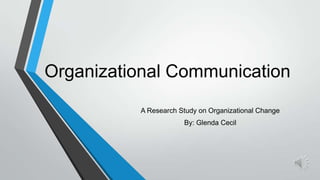Final presentation- Glenda Cecil
- 1. Organizational Communication A Research Study on Organizational Change By: Glenda Cecil
- 2. Organizational Change ? Globalization just one factor among many, necessitating organizational change ? IBM reveals 60 percent rate of organizational change failure (Hunt, 2008) ? Thesis- Communication channels and organizational culture Retrieved from http://blog.bpmcpa.com/
- 3. Motive and Past Research ? Research on the topic of organizational change is lacking (Lewis, 1999) ? Past research has established the following: ? Lewis (1999), informal channels are more often used ? Torppa and Smith (2001), positive outlook yields receptiveness to change ? Jian (2007), there are unintended consequences of change Retrieved from http://www.brighthubpm.com/changemanagement/88725-tips-on-managing-theorganizational-change-curve/
- 4. Variables ? Variables include: ? Organizational Culture ? Employee Perceptions ? Communication Channels Retrieved from http://www.learn.eaglesflight.com/blog/bid/ 133192/Perceptions-Rule Retrieved from http://www.superoffice.com/blog/handling-customerservice-in-multiple-communication-channels-2/
- 5. Theory ? Pacanowsky and O¡¯Donnell-Trujillo¡¯s Organizational Culture Theory ? Culture not equal to race or ethnicity in this context ? However, employee attitudes, actions, and customs of the organization ? Provides a method of interpretation
- 6. Research Questions ? RQ1: Is successful change implementation dependent upon organizational culture moral and employee perceptions of change benefits and disadvantages ? RQ2: Do the behaviors of employees influence other employee¡¯s support level of organizational change ? RQ3: Are employee¡¯s perceptions of change implementation contingent upon the channels used to impart change messages
- 7. Participants & Method ? 20 teachers and teacher¡¯s aides from a large school corporation in the Midwest ? Ages- 19 to 54 years ? Female- 18 (90%) ? Male- 2 (10%) ? Tenure- 2 months to 14 years _________________________________________________________ ? Questionnaires self-administered via email ? 20 distributed, 12 (60%) completed and returned
- 8. Measures ? Questions measurable against 5-point Likert scale ? 1 being strongly disagree, 5 being strongly agree ? Scales used, ? Organizational Culture- Cooke & Lafferty¡¯s (1989) Organizational Culture Inventory (OCI) Scale ? Influence- Armenakis et al. (2007) Organizational Change Recipients¡¯ Belief Scale (OCRBS) ? Communication Channels- W. Downs and Hazen (1977) Communication Satisfaction Questionnaire (CSQ) Retrieved from http://www.qualitylogoproducts.com/desktop-items/jo-bee-6in-wooden-ruler.htmtrieved from
- 9. Data Analysis ? Questionnaires returned to assess variables Organizational Culture Influence Communication Channels Retrieved from http://ityphoon.org/?p=386 Retrieved fromhttp://www.trexglobal.com/property -management/real-estatenews/news/property-management-howsocial-media-opens-communicationchannels-for-real-estate-investorslandlords http://www.technologyblogged.com/businesstechnology/five-communication-channels-everybusiness-needs
- 10. Results ?Research Question 1- likely confirmed ?Research Question 2- likely confirmed ?Research Question 3- likely confirmed
- 11. Limitations ? Small sample size Retrieved from http://www.bayesian-inference.com/samplesize ? Use of a subgroup Retrieved from http://thoughtsonthirteenreasonswhy.wordpress.com/tag/cassette-5/
- 12. Conclusion It could¡ be up to you Retrieved from http://medcitynews.com/2012/07/healthcare-innovation-tech-transfer-patriotic-duties-for-universities/
- 13. References Hunt, L. H. (2008). IBM Global Study: Majority of Organizational Change Projects Fail. Retrieved from http://www 03.ibm.com/press/us/en/pressrelease/25492.wss Jian, G. (2007). Unpacking unintended consequences in planned organizational change: A process model. Management Communication Quarterly, 21(1), 5-28. doi: 10.1177/0893318907301986 Lewis, L. K. (1999). Disseminating information and soliciting input during planned organizational change: Implementers' targets, sources, and channels for communicating. Management Communication Quarterly : McQ, 13(1), 43-75. doi: 10.1177/0893318999131002 Torppa, C. B., & Smith, K. L. (2011). Organizational change management: A test of the effectiveness of a communication plan. Communication Research Reports, 28(1), 62-73. doi: 10.1080/08824096.2011.541364 Armenakis, A., Bernerth, J. B., Pitts, J. P., & Walker, H. J. (2007). Organizational change recipients¡¯ beliefs scale: Development of an instrument. Journal of Applied Behavioral Science, 43, 481¨C505. doi: 10.1177/0021886307303654 Cooke, R. A., Szumal, J. L. (1993). Measuring normative beliefs and shared behavioral expectations in organizations: The reliability and validity of the organizational culture inventory. Psychological Reports, 72, Issue, pp. 1299-1330. doi: 10.2466/pr0.1993.72.3c.1299 Downs, C. W., & Hazen, M. D. (1977). A factor analytic study of communication satisfaction. Journal Of Business Communication, 14(3), 63-73. Retrieved from http://job.sagepub.com/













